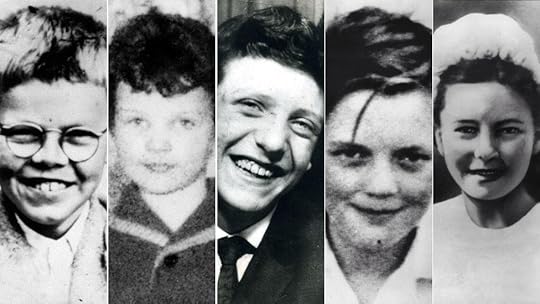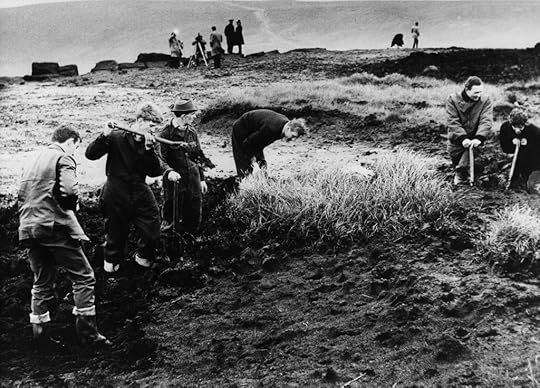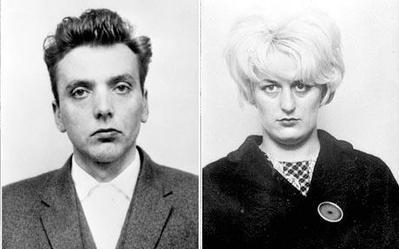The Intersection of History and Horror: Understanding the Moors Murders through Criminal Psychology
The Moors Murders, often cited as one of Britain’s most notorious crimes, represent a chilling intersection of historical crime and the darker facets of human psychology (particularly when viewed through the lens of criminal psychology). As we delve into this infamous case, it serves not only as a grim reminder of the past, but also as a compelling study for true crime enthusiasts and historians alike who seek to understand the intricate workings of the criminal mind.
The gruesome acts committed by Ian Brady and Myra Hindley in the 1960s (which shocked the nation and left an indelible mark on British history) prompt us to question the societal and psychological factors that could lead to such heinous behavior. By examining these historical crime cases, we can foster a deeper discussion about the potential for darkness within human nature and the societal structures that both constrain and, occasionally, enable such transgressions.
 Britain’s Notorious Crimes: A Brief Overview
Britain’s Notorious Crimes: A Brief OverviewWhen exploring Britain’s notorious crimes, certain cases inevitably rise to prominence due to their sheer impact and the lingering questions they pose. The Moors Murders stand alongside other infamous criminal acts like the Jack the Ripper killings and the Yorkshire Ripper attacks, each leaving a distinct mark on the national psyche. These crimes, while separated by time and circumstance, share common threads—public outrage, intense media scrutiny, and a profound societal introspection.
The Moors Murders, in particular, highlighted the vulnerabilities in 1960s Britain, not only in terms of law enforcement’s ability to apprehend offenders but also in the ways society grapples with such profound evil. By examining these historical crime cases, scholars and enthusiasts alike can gain insight into the darkest recesses of human behavior and the societal factors that can either contain or exacerbate such tendencies. Understanding these events requires an appreciation of their historical context and the psychological complexities involved.
True Crime Enthusiasm and Historical ContextThe allure of true crime, particularly regarding cases like the Moors Murders, is deeply rooted in an intense curiosity about the darker aspects of human nature and the historical conditions that foster them. This enthusiasm is not merely about sensationalism; it involves a profound desire to comprehend the complexities of criminal psychology and societal impact.
During the 1960s, Britain was undergoing significant cultural and social transformations, with the Moors Murders occurring against this backdrop of change. This context magnifies the intrigue surrounding the case—how did such atrocities occur in a society on the brink of modernity?
For historians, the Moors Murders serve as a lens through which we can examine the interplay between individual pathology and broader societal dynamics. By understanding the era in which these crimes were committed, we gain valuable insights into the conditions that may have facilitated such criminal behavior, thus enriching our grasp of both historical crime cases and human psychology.
 Criminal Psychology’s Role in Crime Analysis
Criminal Psychology’s Role in Crime AnalysisCriminal psychology offers crucial insights into understanding the motivations and behaviors behind heinous acts like the Moors Murders. This discipline examines the psychological makeup of offenders, seeking patterns that might explain why individuals commit such crimes. By analyzing Ian Brady and Myra Hindley’s psychological profiles, experts can uncover the interplay between their personalities, past experiences, and the sociocultural environment of 1960s Britain. Through this lens, professionals in the field can explore how psychopathological traits—such as lack of empathy, manipulativeness, and a need for control—might have driven their actions. Moreover, criminal psychology provides valuable frameworks for assessing risk factors and identifying warning signs in potential offenders, thereby aiding in both prevention and rehabilitation efforts. In the context of historical crime cases, these analyses not only enhance our comprehension of individual cases but also contribute to a broader understanding of criminal behavior, enabling society to better address and mitigate the conditions that lead to such tragic events.
The Mind of a Killer: Analyzing Ian BradyIan Brady, one of the central figures in the Moors Murders, presents a chilling case study for criminal psychologists. His actions and mindset provide profound insights into the psychological underpinnings of a killer. Brady, often described as a sociopath, displayed traits such as a lack of empathy, manipulative behaviors, and a profound detachment from societal norms. His fascination with Nazi ideology and literature on sadism reveals an obsession with power and control (a characteristic often seen in individuals who commit violent crimes). Furthermore, Brady’s methodical approach to his crimes indicates a calculated and deliberate mindset, aiming to exert dominance over his victims. By dissecting Brady’s psychological profile, experts can better understand how certain cognitive and emotional deficits might predispose individuals to commit such atrocities. This analysis not only aids in comprehending the Moors Murders but also contributes to the broader field of criminal psychology, offering tools for identifying and managing potential risks in similar profiles.
 Myra Hindley: A Complex Psychological Portrait
Myra Hindley: A Complex Psychological PortraitMyra Hindley’s involvement in the Moors Murders complicates the narrative of criminal partnerships, offering a complex psychological portrait that continues to perplex researchers. Unlike Ian Brady, Hindley’s motivations and psychological profile suggest a nuanced interplay of influence and autonomy. While some argue that Hindley was manipulated by Brady, evidence also points to her active participation and willingness to engage in criminal acts. Her background reveals a desire for acceptance and control, which may have made her susceptible to Brady’s influence. However, it is essential to recognize her agency in the crimes committed. Hindley’s psychological profile raises questions about the dynamics of criminal partnerships and the factors that contribute to an individual’s descent into criminality. By examining her motives and personality traits, experts can explore how personal vulnerabilities and external influences converge to facilitate such behavior. This understanding aids in developing more effective psychological assessments and interventions in preventing similar crimes in the future.
Criminal Psychology and Historical Crime CasesThe application of criminal psychology to historical crime cases like the Moors Murders provides valuable insights into the minds of perpetrators, illuminating how past events can inform current understandings of criminal behavior. By analyzing Ian Brady and Myra Hindley’s psychological profiles within their historical context, experts can discern patterns and traits that might have contributed to their criminal actions. This retrospective examination offers a dual benefit: enhancing our comprehension of notorious crimes and enriching the field of criminal psychology with real-world case studies. Historical analysis also highlights the societal and psychological conditions that can precipitate such crimes, thereby offering a framework for preventing future occurrences. Furthermore, studying these cases allows psychologists to refine profiling techniques, improving the accuracy of identifying potential threats. In sum, integrating criminal psychology with historical crime cases not only deepens our understanding of specific offenders but also contributes to broader efforts in crime prevention and psychological assessment.
Challenging Stereotypes in True Crime NarrativesTrue crime narratives often risk perpetuating stereotypes that simplify complex criminal behaviors into reductive archetypes. In examining the Moors Murders, it is crucial to challenge these stereotypes, fostering a more nuanced understanding of the perpetrators and their actions. Simplistic portrayals can obscure the intricate psychological and societal factors that contribute to criminality, leading to misconceptions about the nature of crime and punishment. For instance, depicting Ian Brady and Myra Hindley solely as “monsters” neglects the broader context of their lives, including psychological predispositions and the socio-cultural environment of 1960s Britain. By acknowledging the multifaceted elements at play, true crime narratives can encourage a more comprehensive discourse that questions societal norms and explores the underlying causes of crime. This approach not only provides a deeper understanding of historical crime cases but also promotes empathy and awareness, challenging audiences to reconsider preconceived notions about criminality and its roots.
The Moors Murders’ Influence on Public PerceptionThe Moors Murders significantly shaped public perception of crime and criminality in Britain, leaving an enduring impact on societal attitudes. This case, with its shocking brutality and the involvement of seemingly ordinary individuals, challenged the public’s belief in the safety and morality of their communities. It sparked widespread fear and distrust, provoking questions about the nature of evil and the potential for such acts within society. The intense media coverage that accompanied the trial further amplified these fears, as sensational headlines and graphic details captured the nation’s attention. As a result, the Moors Murders became a cultural touchstone for discussions about crime, influencing public policy and perceptions of justice. The case also highlighted the need for better understanding and management of criminal behavior, prompting advancements in criminal psychology and law enforcement practices. Ultimately, the Moors Murders serve as a cautionary tale, reminding society of the complexities and potential darkness inherent in human nature.
Bridging History and Horror through Criminal PsychologyThe intersection of history and horror, particularly in the context of the Moors Murders, offers a unique opportunity to explore the depths of human behavior through criminal psychology. This approach allows us to bridge the gap between historical events and their horrific elements, leading to a more profound comprehension of both. By analyzing the psychological profiles of perpetrators like Ian Brady and Myra Hindley, we gain insight into the factors that drive individuals to commit unspeakable acts. This exploration highlights the relevance of historical crime cases in understanding contemporary issues of crime and punishment, emphasizing the timeless nature of these challenges. Moreover, examining the Moors Murders through this lens invites a broader discourse on the societal structures and psychological conditions that enable such transgressions. Ultimately, integrating criminal psychology with historical analysis not only enriches our understanding of past events but also equips us with the knowledge to address and prevent similar horrors in the future.



